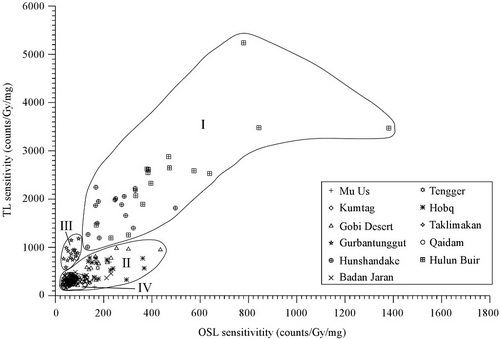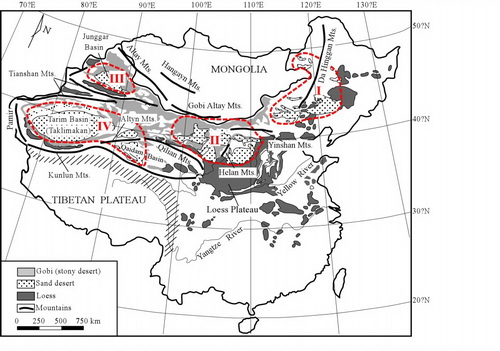Luminescence sensitivities of quartz grains from eolian deposits in northern China and their implications for provenanceUpdate time:09 05, 2011
Ph.D. student Lü Tongyan and her teacher SUN Jimin use the luminescence sensitivities of quartz grains to study the provenance of deserts. In this study, nine modern dune sand samples were collected from different deserts. Moreover, they also collected three Quaternary loess samples (L1, L15, and L33) and one Tertiary red clay sample from the Jingbian section , which is located in the northern Loess Plateau , in order to examine the temporal provenance changes. Based on the luminescence sensitivity variations of quartz grains from Chinese deserts, four regional groups of deserts can be distinguished including the eastern (Hulun Buir and Hunshandake), central (Gobi Desert, Badain Jaran, Tengger, Hobq, and Mu Us), western (Taklimakan, Qaidam, and Kumtag), and northwestern (Gurbantonggut) deserts. The different luminescence sensitivity signals are dominantly related to the rock types of mountains surrounding or adjacent to the deserts. The luminescence sensitivity of Tertiary red clay is higher than that of Quaternary loess (L1, L15, and L33) mostly implies that the provenance of the Chinese eolian deposits changed since the beginning of the Quaternary. Lü and Sun.Luminescence sensitivities of quartz grains from eolian deposits in northern China and their implications for provenance. Quaternary Research, 2011, 76: 181-189.(Download Here)
Figure 1 TL and OSL luminescence sensitivities of quartz particles (90–125 μm fraction) from deserts in northern China, noting the samples fall into four groups. (Image by Lü Tongyan)
Figure 2. Map showing the corresponding geographic locations of the four groups of deserts according to their spatial luminescence sensitivities. (Image by Lü Tongyan)
|
Contact
Related Articles
Reference
|
-
SIMSSecondary Ion Mass Spectrometer Laboratory
-
MC-ICPMSMultiple-collector ICPMS Laboratory
-
EM & TEMElectron Microprobe and Transmission Electron Microscope Laboratory
-
SISolid Isotope Laboratory
-
StIStable Isotope Laboratory
-
RMPARock-Mineral Preparation and Analysis
-
AAH40Ar/39Ar & (U-Th)/He Laboratory
-
EMLElectron Microscopy Laboratory
-
USCLUranium Series Chronology Laboratory
-
SASeismic Array Laboratory
-
SEELaboratory of Space Environment Exploration Laboratory
-
PGPaleomagnetism and Geochronology Laboratory
-
BioMNSFrance-China Bio-mineralization and Nano-structure Laboratory

 Print
Print Close
Close

